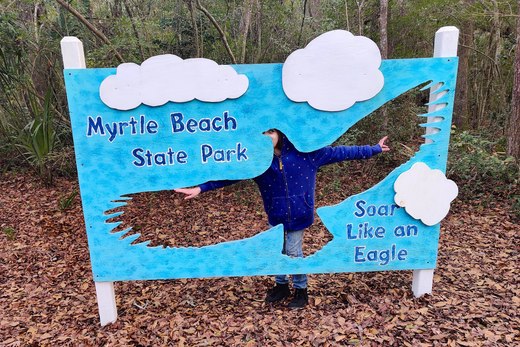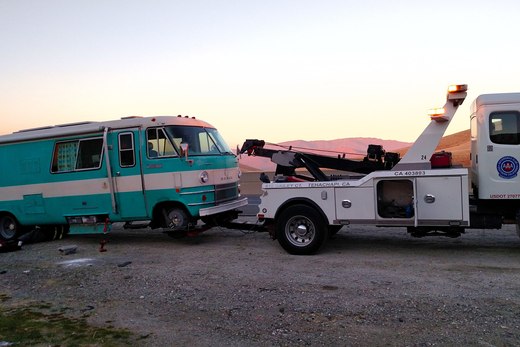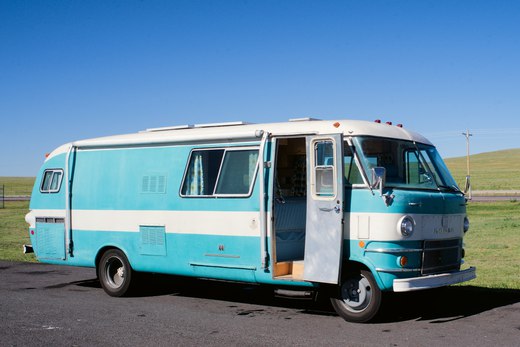Why Live in a Vintage 1969 RV?
The less you have, the further you can go.
Everything smells like grapefruit.
Out of the corner of my eye I can see the Colorado sunshine, but under here it’s dark and cramped and it smells like grapefruit. The smell is transmission fluid, a slick, translucent red lubricant with an unpleasantly sweet citrus odor. I’ve been sticking my hands in it for months, over 4000 miles now, chasing a leak that won’t stop. That leak caused the engine to overheat, leaving me on my back in the grass and gravel at the side of the road half way up Dallas Divide, outside of Ridgway, Colorado. There’s blood on my knuckles, transmission fluid on my forehead and cheek, and I’m half on the ground, half off it, my torso twisted up into the engine, my face inches from an extremely hot radiator, wondering, not for the first time — what in the world am I doing?
It started three years earlier. My wife had just given birth to our third child and we were feeling dissatisfied with life in the American suburbs. We wanted to spend more time outdoors, more time together as a family. A raft of studies has shown that time outside makes us happier, healthier people. What’s more, listening to the wind in the trees, feeling the sun on your face, the rain on your head, the more we experience these things as children, the happier we are as adults. We feel it in our bones, that peace that comes from being outdoors.
We could have moved to the country, we considered it, we may yet, but instead we decided to buy an RV and hit the road to see the whole country. And now, having lived this way for over two years, I can say that, for our family at least, the studies, the things we feel in our bones, are all absolutely right. The best part of the way we live is waking up in the morning and stepping outside. We live outside. We cook outside, we eat outside, we learn outside, we play outside. Only the weather drives us inside.
But before we made the leap to life on the road it was all untested intuition. We knew we wanted to home school, which was an easy choice since my wife is a teacher. As a freelance writer and programmer, I’ve long worked from home. Those two things combined gave us a huge head start on our way to life on the road. Our main hesitation was that we wanted our three children to still have a place they could call their own. We didn’t want to travel, we wanted to take our home on the road.
The logical thing to do was to buy an RV. The problem for us was that modern RV design leaves much to be desired. Most RVs struck us as generic beige boxes, not unlike the suburban housing we wanted to leave behind. Worse, the construction is often very flimsy.
We wanted an RV that would make us smile when we saw it, something that was made of actual steel, and preferably something that didn’t cost a fortune. That’s a tough combo to come across. We were ready to give up on the idea when we discovered the Dodge Travco.
To call it an RV is to say a Stradivarius is a violin. The Travco is not an RV; it’s a 27 foot long fiberglass container full of magic and joy. I have no idea what it is about it, I’ve owned it for four years now, lived in it for over two, and I still can’t put my finger on it. Some objects transcend themselves. The Travco has that thing no one can put their finger on, but everyone feels it.
My wife was not 100 percent sold on the idea of living on the road until she saw the Travco. That combined with a trial trip to Florida added up to an afternoon where, over a couple beers in the sweltering Florida sun, we agreed, let’s do this.
Two days later we bought a 1969 Travco and a few weeks later I went to get it. I fired it up, pointed it downhill, and we were on our way. The first time I stopped, at a rest area on I-85, a man was up at the driver’s window asking if he could take a picture before I’d even taken off my seatbelt. “What is this thing,” he asked excitedly, “it’s the coolest thing I’ve ever seen”. This would happen hundreds of times more over the years and eventually I realized no one really wants me to tell them what it is, the name doesn’t matter, it simply exists and people want to acknowledge that it exists.
I managed to get it the 200 miles back home, despite having no real idea the condition of the engine or brakes. I immediately started ripping out it’s insides, re-wiring, re-plumbing, re-paneling, re-covering things to turn it into something livable for a family of five. The kids took to calling it the big blue bus, a name that has stuck with us ever since.
It’s only 27 feet long, small for an RV by today’s standards, but big enough to sleep six and after two years of living in it we know it’s all we need.
It took me nearly two years to fully restore the bus and even with all that work we left long before everything was done.
We sold our house and moved into the bus before we had working plumbing or propane. It wasn’t until four months into our trip that I finally got around to installing a water tank. Two months after that we got our solar system working. We were more interested in getting on the road than having everything perfect. Even today, after two years on the road I’ve still yet to install a refrigerator. We’ve lived for two years with an ice box and small freezer. Sometimes that’s been a pain. Texas in June, 115 degrees and 99 percent humidity will melt your icebox in a hurry.
That’s been a big lesson of the road though — you need very little to be happy.
Stepping outside the traditional structures of modern life means re-evaluating things, especially that cornerstone of modern life — comfort. Comfort is freedom and independence. Comfort means having sweat glands and metabolic tolerance to deal with heat and cold rather than relying on air conditioning.
There are some things that make life easier, on the road and otherwise, but more things do not make life more easy. Quite the opposite I’d argue — more things mean more things that can break down and more time spent fixing or replacing them. Would it be easier to flip a switch from the inside? Yes, until that switch breaks. The simpler you keep things the less there is to worry about.
Which doesn’t mean there’s nothing to worry about. Like anyone with solar panels, we worry about hail. We get skittish around storms. One afternoon we were headed out of Colorado, bound for Canyonlands. We were heading almost due west, but to the south was started as a gentle tufts of cumulus cloud had, by midday, built into something ominously dark, day turning to night. The distant mountains we were hoping to make camp in were swallowed into the darkness and we watched as lightning snapped out in front of the storm.
We stopped and consulted the map. To the northeast there was a small bit of state land that said it had a campground, but there was no further information. We decided to sit the storm out. We cut off the highway and followed an increasingly narrow dirt road — always a good sign if you’re looking for secluded spots — and ended up with a campsite to ourselves with a canyon wall to one side and a bubbling river on the other.
We unfurled the awning, set up the mat and let the kids take off exploring. Instead of driving headlong into who knows what we spent the afternoon playing in the river, watching the thunderheads roll by far downstream. That even we found bobcat tracks and what might have been some mountain lion prints. The next day we met two women foraging herbs along the river. They told us about a canyon to the east that only locals ever visit, full of petroglyphs and ruins that became our next destination. In fact the next two weeks we explored leads that all came because we turned to avoid a storm.
But I’ve made it sound like we know what we’re doing, which is not true. We have no clue. We make it up as we go along. We stumble along, following our noses as it were. We let the kids decide where we go. We spent a whole summer visiting the region in which Louise Erdrich’s The Birchbark House takes place for no other reason than my daughters and I love the book.
And then there’s a grapefruit smell. The bus breaks down. We spend days at the side of the road. The kids have learned to roll with it. They play games at the table while Daddy mutters under the bus and Mommy searches YouTube for videos on engine repair. We don’t know what we’re doing, but we love doing it.
That particular day I wrapped a combination of duct tape and exhaust tape to stop the leak. I rolled out from under the bus, grabbed some water from in the bus and sat down on the guard railing. To the east the whole of the Cimarron Range spread out before us, it was September, the days growing shorter. I watched as the sun began to soften and light up Chimney Rock and other peaks and I remembered why we do this, why I don’t mind stopping at the side of the road to fix something. There’s nowhere to get to, we’re already there. We limped back to Ridgway where I replaced all the transmission lines. I’ve never had a leak since.




2 Comments
Nice meeting you all. Loved your beginnings story. Happy journies in all your days ahead. Reise and Dreamer say “Hi/Woof” too.
@Stacy-
Thank you for stopping by! It was nice meeting you.
Thoughts?
Please leave a reply:
All comments are moderated, so you won’t see it right away. And please remember Kurt Vonnegut's rule: “god damn it, you’ve got to be kind.” You can use Markdown or HTML to format your comments. The allowed tags are
<b>, <i>, <em>, <strong>, <a>. To create a new paragraph hit return twice.